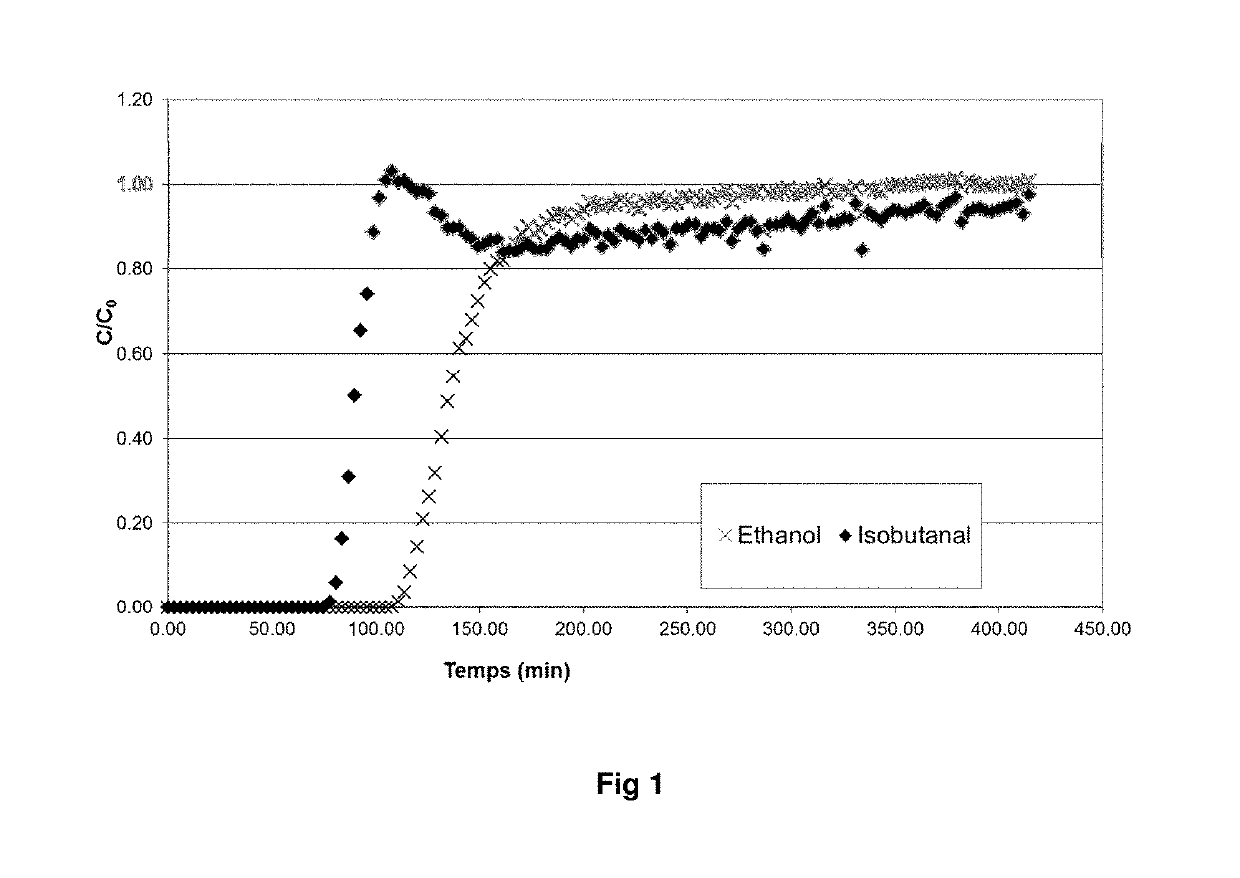Method for simultaneously eliminating isobutanal and ethanol from olefinic feedstocks by adsorption on a porous refractory oxide-based material
- Summary
- Abstract
- Description
- Claims
- Application Information
AI Technical Summary
Benefits of technology
Problems solved by technology
Method used
Image
Examples
examples
[0069]In Examples B and D below, the olefinic feedstock was first stripped with nitrogen and then run over a sieve 3A. At the end of this pretreatment, the water and acetone contents of the feedstock are verified by, respectively, the method of Karl Fischer and gas-phase chromatography according to the UOP 960 method. The olefinic feedstock that is tested in Examples B and D no longer contains either water or acetone.
[0070]In Example C below, the olefinic feedstock was first run over a sieve 3A. An analysis by the method of Karl Fischer shows that, at the end of this pretreatment, the olefinic feedstock that is tested in Example C no longer contains water.
example a
on of an Adsorbent According to the Invention
[0071]The adsorbent is prepared by dry impregnation of a material such as flash alumina, which is shaped by granulation, using a solution of NaOH.
[0072]The alumina selected has a pore volume of 0.5 ml / g, a macropore volume of 0.1 ml / g, a specific surface area of 341 m2 / g, and a sodium content before impregnation of 1,948 ppm by mass.
[0073]The specific surface area is determined by the B.E.T. method according to the Standard ASTM D3663. The total pore volume and the macropore volume are determined by application of the Standard ASTM D4284 by mercury intrusion measurement with a wetting angle of 140°, using a device such as the Autopore III™ model of the Microméritics™ brand. The sodium content is measured by atomic absorption spectroscopy.
[0074]Impregnation is done as follows:
[0075]a) Preparation of 50 mL of a soda (NaOH) solution by dissolving 8.84 g of NaOH in 50 g of water;
[0076]b) Streaming, drop by drop using a burette, of 5 mL of the...
example b
tion of Isobutanal and Ethanol and Production of Purified Butenes
[0082]The adsorbent A, prepared in accordance with Example A, is tested in a fixed-bed reactor at 30° C. under 0.8 MPa. The feedstock is composed of 80% n-butene and 20% isobutene and comprises isobutanal and ethanol in variable proportions (see Table 1, Tests 1 to 3).
[0083]In parallel, an adsorbent of the NaY zeolite type from Zeolyst, white, shaped by pelletizing and crushing, is tested under the same conditions. The feedstock is composed of 80% n-butene and 20% isobutene and comprises isobutanal and ethanol at levels of 3,023 and 963 ppm by mass, respectively.
[0084]The fixed bed of adsorbent is first activated at 290° C. under N2 for 12 hours and is then filled with butane at 30° C. under 0.8 MPa. The feedstock is then injected into the reactor at a flow rate of 0.5 ml / min continuously, i.e., an hourly volumetric flow rate of 0.5 h−1.
[0085]The tracking of the concentrations of isobutanal and ethanol at the reactor o...
PUM
| Property | Measurement | Unit |
|---|---|---|
| Temperature | aaaaa | aaaaa |
| Temperature | aaaaa | aaaaa |
| Temperature | aaaaa | aaaaa |
Abstract
Description
Claims
Application Information
 Login to View More
Login to View More - R&D
- Intellectual Property
- Life Sciences
- Materials
- Tech Scout
- Unparalleled Data Quality
- Higher Quality Content
- 60% Fewer Hallucinations
Browse by: Latest US Patents, China's latest patents, Technical Efficacy Thesaurus, Application Domain, Technology Topic, Popular Technical Reports.
© 2025 PatSnap. All rights reserved.Legal|Privacy policy|Modern Slavery Act Transparency Statement|Sitemap|About US| Contact US: help@patsnap.com

